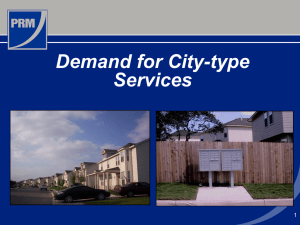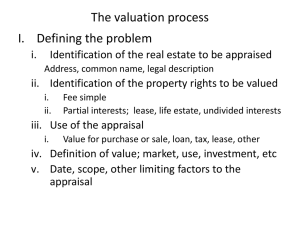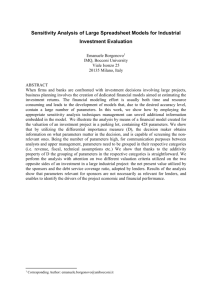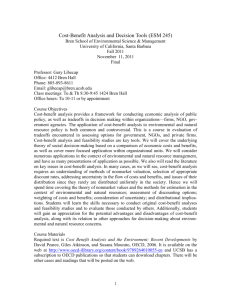ESM 245 - Bren School of Environmental Science & Management
advertisement
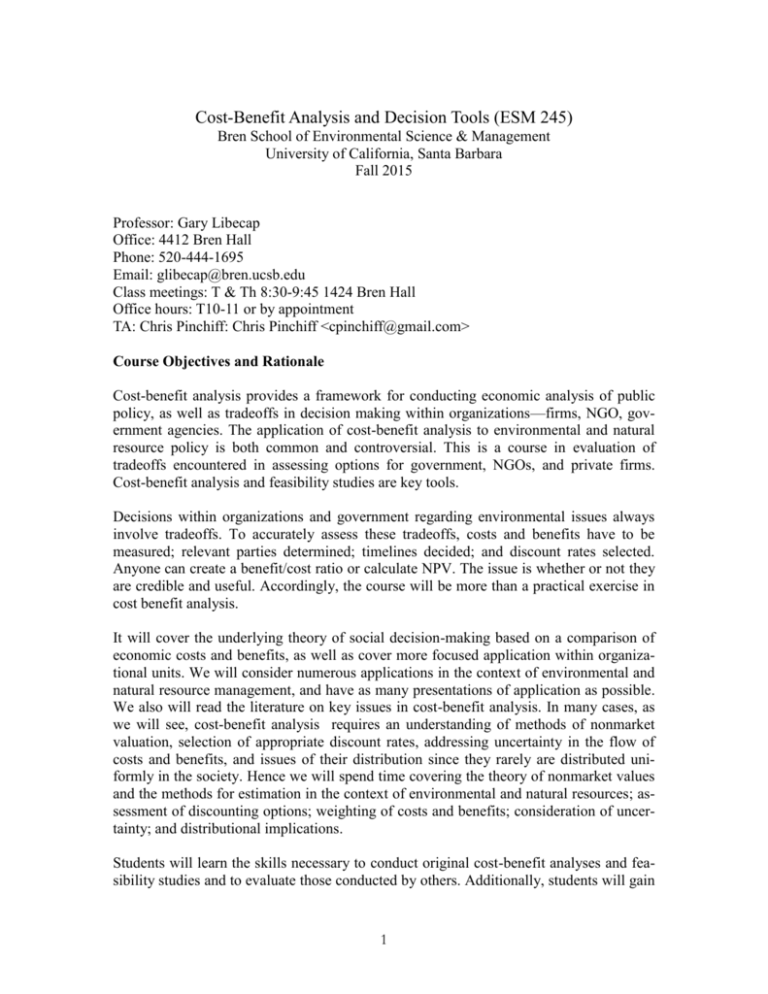
Cost-Benefit Analysis and Decision Tools (ESM 245) Bren School of Environmental Science & Management University of California, Santa Barbara Fall 2015 Professor: Gary Libecap Office: 4412 Bren Hall Phone: 520-444-1695 Email: glibecap@bren.ucsb.edu Class meetings: T & Th 8:30-9:45 1424 Bren Hall Office hours: T10-11 or by appointment TA: Chris Pinchiff: Chris Pinchiff <cpinchiff@gmail.com> Course Objectives and Rationale Cost-benefit analysis provides a framework for conducting economic analysis of public policy, as well as tradeoffs in decision making within organizations—firms, NGO, government agencies. The application of cost-benefit analysis to environmental and natural resource policy is both common and controversial. This is a course in evaluation of tradeoffs encountered in assessing options for government, NGOs, and private firms. Cost-benefit analysis and feasibility studies are key tools. Decisions within organizations and government regarding environmental issues always involve tradeoffs. To accurately assess these tradeoffs, costs and benefits have to be measured; relevant parties determined; timelines decided; and discount rates selected. Anyone can create a benefit/cost ratio or calculate NPV. The issue is whether or not they are credible and useful. Accordingly, the course will be more than a practical exercise in cost benefit analysis. It will cover the underlying theory of social decision-making based on a comparison of economic costs and benefits, as well as cover more focused application within organizational units. We will consider numerous applications in the context of environmental and natural resource management, and have as many presentations of application as possible. We also will read the literature on key issues in cost-benefit analysis. In many cases, as we will see, cost-benefit analysis requires an understanding of methods of nonmarket valuation, selection of appropriate discount rates, addressing uncertainty in the flow of costs and benefits, and issues of their distribution since they rarely are distributed uniformly in the society. Hence we will spend time covering the theory of nonmarket values and the methods for estimation in the context of environmental and natural resources; assessment of discounting options; weighting of costs and benefits; consideration of uncertainty; and distributional implications. Students will learn the skills necessary to conduct original cost-benefit analyses and feasibility studies and to evaluate those conducted by others. Additionally, students will gain 1 an appreciation for the potential advantages and disadvantages of cost-benefit analysis, along with its relation to other approaches for decision-making about environmental and natural resource concerns. Students will apply this learning to a real project that has both private and public benefits and costs with implications for all aspects of environmental decision making. All group projects represented in the class will have a cost benefit analysis completed by the end of the term. Approach and Grading Students will divide into teams of 3-5. The objective is to have teams organized around Group Projects. Each team will conduct a cost benefit analysis for the Group Project. Grading will be based on a). class discussion of course material and comprehension of material as applied to the GP. b). critiques of the CBA analyses of other GPs and a final CBA for the Group Project due at the end of the term to include details on approach, problems encountered, caveats, references, and technical appendix, if appropriate. Students will be graded individually on CBA problems assigned separately in class. Course Materials Required text is Cost Benefit Analysis and the Environment: Recent Developments by David Pearce, Giles Atkinson, and Susana Mourato, OECD, 2006. It is available on the web at http://www.oecd-ilibrary.org/content/book/9789264010055-en and UCSB has a subscription to OECD publications so that students can download chapters. There will be other cases and readings that will be posted on the web. Other course materials for the project will be posted. Course Requirements You are expected to complete all of the assigned reading before class, as lectures will build on, rather than reiterate, reading material. The aim is to have much of class based on discussion, so being prepared will be important. Classes generally will involve lectures and student team presentations and critiques on the other or discussion of CBA problems. All team assignments will be due the day prior at 8 am. Presenting teams will take 10 minutes, followed by 10 minutes of class discussion. Tentative Course Outline and Reading List September 24: Course Overview, Group Project Team Formation. 2 Course overview. Team discussion. GP teams due to Libecap by Tuesday September 29. September 29: What is Cost-Benefit Analysis (CBA) and Why is it Important? Lecture 1 Review of microeconomic principles for environmental management. Efficiency criterion and what that means. Introduction to CBA. Matt Kotchen, “Cost-Benefit Analysis” Encyclopedia of Climate and Weather, 2nd Ed, Oxford University Press, 2010. Pearce, et al, 2006, Chapters 1, 2 October 1: Introduction to Evaluation Tools. Lecture 2 Readings: Pearce, et al, 2006, Chapters 3-4. Introduction to discounting, distribution of costs and benefits, impact of shifting costs to benefits, scale effects, differences in time frame across options. Discussion of: Benefit-Cost Ratios, Cost Minimization, Net Present Value Analysis, Internal Rate of Return, Equivalent Annual Net Benefits. Problem set introduction: Evaluation of transportation improvement options for Houston: Buses or Light Rail. Individuals submit analysis to Chris Pinchiff/Gary Libecap by 8 am Monday October 5 and be prepared to lead discussion on the 6th. October 6: Problem Set 1 Discussion of Houston transport problem led by Chris Pinchiff and selected students. October 8: 3: Cost-Benefit Analysis, Introduction to Conceptual Issues and Cost Assessment. Lecture 3. Readings: Pearce et al Chapter 5 Direct and indirect costs and their importance in CBA. October 13, 15: Cost and Benefit Considerations: Concepts and Measurement and Distribution and its Importance. Lecture 4 Readings: Pearce et al Chapter 6 Segerson (2014) “Distribution and Compensation in Economics” Rubin et al. (1991) “A Benefit-Cost Analysis of the Northern Spotted Owl,” Journal of Forestry December 25-30. 3 Lueck and Michael (2003) “Pre-emptive Habitat Destruction under ESA” Journal of Law and Economics” 46: 27-60. Problem set #2 due by 8 am October 19. October 20: Problem Set 2 Discussion. October 22: Introduction to Benefit Valuation: Revealed Preference: Lecture 5 Readings: Pearce et al Chapter 6, 7. Various means of determining value from revealed preference. Averting Behavior Schmidt and Courant (2006) “Sometimes Close is Good Enough: The Value of Nearby Environmental Amenities,” Journal of Regional Science. 46(5): 931-51 October 27: First Team Presentations with Critical Reviews by Class: Benefit/Cost Valuation: 10 minutes per team. 3-4 teams. October 29: Introduction to Benefit Valuation: Revealed Preference Continued: Lecture 6 Readings: Pearce et al Chapter 7. Travel Cost Estimates Tobias and Mendelsohn (1991), “Valuing Eco Tourism in a Tropical Rain-Forest Reserve, “Ambio. October 29 Introduction to Benefit Valuation: Revealed Preference Hedonic Prices—property valuation Hedonic Pricing discussion file. Examples of Hedonic Pricing Calculations. November 3: Problem Set # 3 Discussion Problem Set 3 solution due 8 am Monday November 2. November 5: Introduction to Benefit Valuation Continued; Contingent Valuation. Examples Lecture 7 Stated Preference: Introduction to Contingent Valuation and Existence Value. Readings: Pearce, et al, Chapter 7, 8. Catherine L. Kling, Daniel J. Phaneuf, and Jinhua Zhao (2012) “From Exxon to BP: Has Some Number Become Better than No Number?” Journal of Economic 4 Perspectives 26( 4): 3–26. John Loomis and Douglas Larson, (1994), “Total Economic Values of Increasing Gray Whale Populations; Results from a Contingent Valuation Survey of Visitors and Households,” Marine Resource Economics 9: 275-86. November 10: Second Team presentations on Benefit/Cost calculations, 10 minutes per team, 34 teams. November 12: Introduction to Benefit Valuation Continued; Contingent Valuation Examples, Continued. Lecture 8. Edward Barbier (2012) “Progress and Challenges in Valuing Coastal and Marine Ecosystem Services,” Review of Environmental Economics and Policy, 6(1):1–19. Kotchen and Burger (2007) “Should we Drill in the Arctic National Wildlife Refuge? An Economic Perspective,” Energy Policy November 17: Introduction to Benefit Valuation Continued; Contingent Valuation Examples, Continued. Kotchen and Reiling (2000) “Environmental Attitudes, Motivations, and Contingent Valuation of Nonuse Values: A Case Study Involving Endangered Species,” Ecological Economics32: 93-107. Discussion of survey instruments: Kotchen and Reiling; Loomis November 19: Third Team Presentations on Cost/Benefit Calculations, 10 minutes per team, 3-4 teams. November 24: Problem Set #4 Discussion. Problem solution due 8 am November 23rd. November 26: No class Thanksgiving Holiday December 1: Valuing Health and Life Risk: Lecture 10. Pearce et al, Chapter 14 James K. Hammitt (2007) “Valuing Changes in Mortality Risk; Lives Saved Versus Life Years Saved” REEP 1(2): 228-233 only. W. Kip Viscusi (2008) “Value of Life” Palgrave Dictionary of Economics December 3: Benefit Measures: Health 5 Lecture 11. December 7, 8 am: GP CBA analysis due. All research papers (10 pages with references for each project). 6

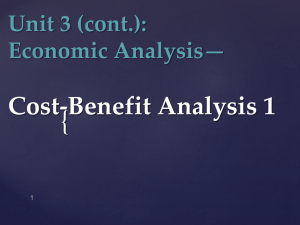

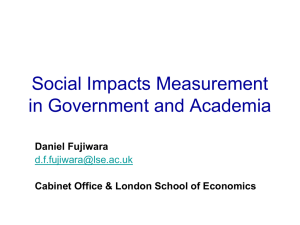
![Presentation [PPT 753KB] - Public Libraries Connect](http://s2.studylib.net/store/data/005428441_1-4e974eda4e2f7484e83126d0526484e4-300x300.png)
